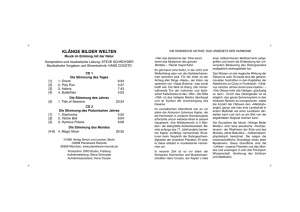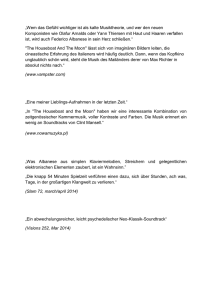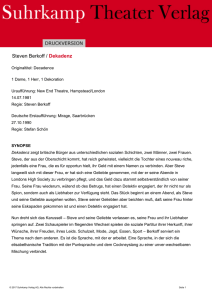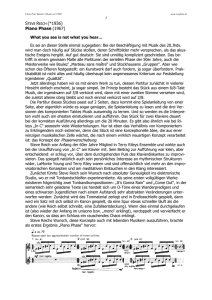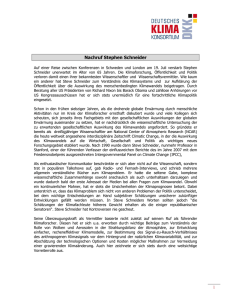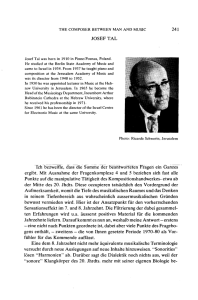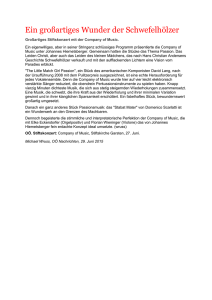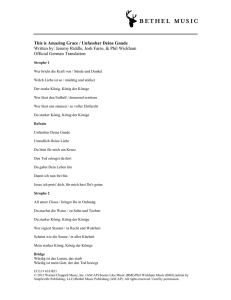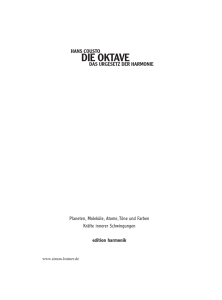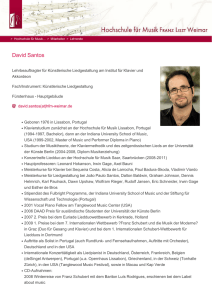29x21cm 11x8 - Planetware Records
Werbung
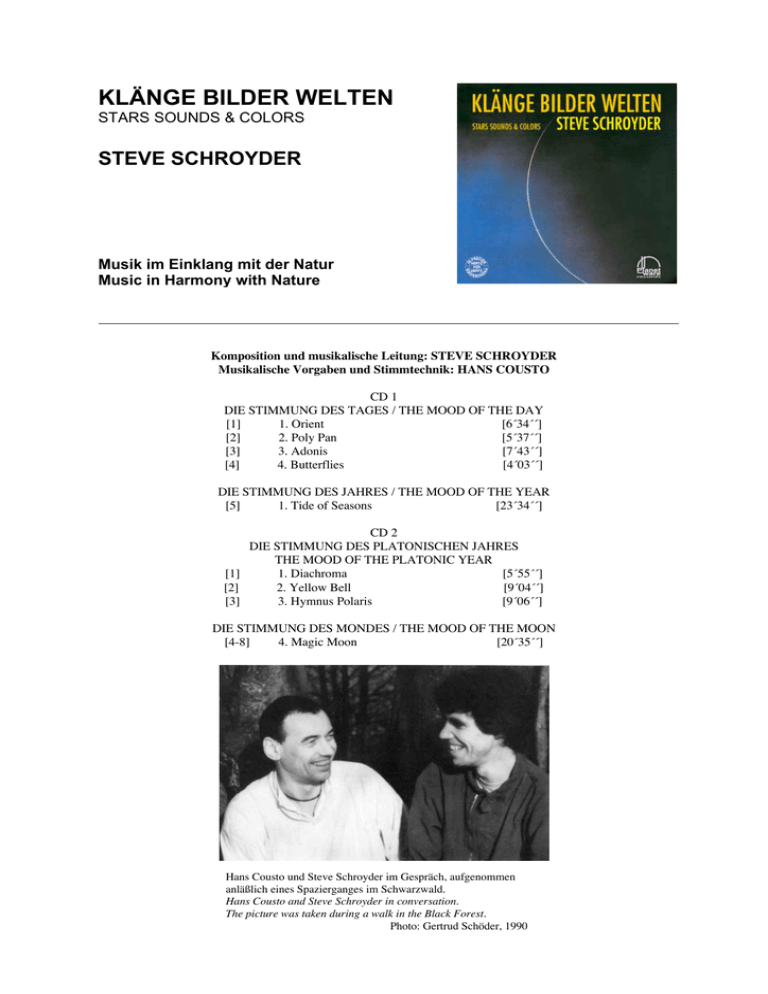
KLÄNGE BILDER WELTEN STARS SOUNDS & COLORS STEVE SCHROYDER Musik im Einklang mit der Natur Music in Harmony with Nature Komposition und musikalische Leitung: STEVE SCHROYDER Musikalische Vorgaben und Stimmtechnik: HANS COUSTO CD 1 DIE STIMMUNG DES TAGES / THE MOOD OF THE DAY [1] 1. Orient [6´34´´] [2] 2. Poly Pan [5´37´´] [3] 3. Adonis [7´43´´] [4] 4. Butterflies [4´03´´] DIE STIMMUNG DES JAHRES / THE MOOD OF THE YEAR [5] 1. Tide of Seasons [23´34´´] CD 2 DIE STIMMUNG DES PLATONISCHEN JAHRES THE MOOD OF THE PLATONIC YEAR [1] 1. Diachroma [5´55´´] [2] 2. Yellow Bell [9´04´´] [3] 3. Hymnus Polaris [9´06´´] DIE STIMMUNG DES MONDES / THE MOOD OF THE MOON [4-8] 4. Magic Moon [20´35´´] Hans Cousto und Steve Schroyder im Gespräch, aufgenommen anläßlich eines Spazierganges im Schwarzwald. Hans Cousto and Steve Schroyder in conversation. The picture was taken during a walk in the Black Forest. Photo: Gertrud Schöder, 1990 Inhalt / content: Die Kosmische Oktave: Das Urgesetz der Harmonie ........... Hinweise an die Hörer/innen ................................................. Die Stimmung des Tages ....................................................... Die Stimmung des Jahres / Die Stimmung des Platon. Jahres Die Stimmung des Mondes / Das Geheimnis der Stimmung Der Wissenschaftler und Autor Hans Cousto ........................ Der Komponist und Musiker Steve Schroyder ...................... The Cosmic Octave: The Primordial Law of Harmony ........ Comments for Listeners ........................................................ The Mood of the Day / The Mood of the Year ....................... The Mood of the Platobic Year / The Mood of the Moon ..... The Magic of Mood .............................................................. The Scientist and Author Hans Cousto ................................ The Composter and Musician Steve Schroyder ................... 2 3 3 4 5 6 6 7 7 8 9 10 10 11 ©1990 Verlag Simon und Leutner, Berlin ©2006 Planetware Records Augustenfelder Str. 24 a, 80999 Munich www.planetware-records.de Komposition und musikalische Leitung / Composition und musical director: Steve Schroyder Musikalische Vorgaben und Stimmtechnik / Musical precept und tuning technique: Hans Cousto Production: OXO-Studio, Freiburg Recording supervision: Steve Schroyder Recording assistance: Hans Cousto DIE KOSMISCHE OKTAVE: DAS URGESETZ DER HARMONIE »Wer das Geheimnis der Töne kennt, kennt das Mysterium des ganzen Weltalls.« Hazrat Inayat Kahn Es gibt kaum eine Kultur, in der nicht vom Weltenklang oder von den Sphärenharmonien berichtet wird. Für die Inder ist der Anfang aller Dinge »Nada«, der Urton, sie sprechen von »Nada Brahma« was soviel heißt wie: Die Welt ist Klang. Der immerwährende Ton der indischen und tibetischen Kulturkreise ist das »OM«. Die Silbe »OM« ist das heiligste Mantra überhaupt und ist Symbol der Urschwingung des Daseins. Im europäischen Abendland war es vor allem der Astronom Johannes Kepler, der die Harmonien in unserem Sonnensystem erforschte und er widmete ihnen in seinem Hauptwerk »Die Weltharmonik in 5 Bänden« die allergrößte Aufmerksamkeit. Bereits anfangs des 17. Jahrhunderts bemerkte Kepler auffällige harmonikale Strukturen beim Vergleich der Bahngeschwindigkeiten der einzelnen Planeten. Er setzte diese alsbald in musikalische Harmonien um. In neuerer Zeit ist es vor allem der Schweizer Harmoniker und Musikwissenschaftler Hans Cousto, der Kepler´s Idee einer vollkommenen Weltharmonik aufgegriffen und durch die Entdeckung der universellen Bedeutung des Oktavgesetzes maßgeblich weitergebildet hat. Das Wissen um die magische Wirkung der Oktave ist uralt. So lautet eine der geheimnisvollen Inschriften in den Kapitellen der Abteikirche zu Cluny in Frankreich: »Oktavus sanctos omnes docet esse beatos« – »Die Oktave lehrt alle Heiligen, glückselig zu sein«. Durch das Oktavgesetz ist es möglich, das ganze Sonnensystem in den hörbaren Bereich zu transponieren, wobei die Anzahl der Oktaven den »Maßstab« angibt, genau wie man eine Landschaft in einem Maßstab auf einer Landkarte darstellen kann und sich so ein Bild von der abgebildeten Gegend machen kann. Die Grundtöne der Musik »Klänge Bilder Welten« sind reine akustische »Hochpotenzen« der Rhythmen der Erde und des Mondes, echte Naturtöne – mathematisch-physikalisch berechnet. Sie zeigen die wissenschaftliche Grundlage eines alten Mysteriums. Diese Grundtöne sind die »Urtöne« unseres Planeten und des Mondes und vereinigen in sich drei Prinzipien: Wissenschaft, Verehrung des Schönen und Meditation. Diese drei Prinzipien sind auch die Grundlage des »Glasperlenspiels«, für das Hermann Hesse im Jahre 1946 den Nobelpreis für Literatur erhielt. Er beschreibt in diesem Buch die Grundsätze des Glasperlenspiels wie folgt: »... eine neue Sprache, nämlich eine Zeichen- und Formelsprache, an welcher die Mathematik und die Musik gleichen Anteil hatten, in welcher es möglich wurde, astronomische und musikalische Formen zu verbinden, Mathematik und Musik gleichsam auf einen gemeinsamen Nenner zu bringen.« Das Gesetz der Oktave ist jener Grundsatz, an welchem die Mathematik und die Musik gleichen Anteil haben, es ist jene Formel, mit welcher es möglich ist, astronomische und musikalische Formeln zu verbinden Astronomie, Mathematik und die Musik, ja auch die Farblehre auf einen gemeinsamen Nenner zu bringen. HINWEISE AN DIE HÖRER/INNEN Die Kompositionen von »Klänge Bilder Welten« gründen in unterschiedlichen kosmischen Grundkonstellationen. Ausgangspunkt sind astronomisch-physikalische Gegebenheiten, die Grundton, Intervalle der Tonleitern und Rhythmus bestimmen. Die Musik ist Hertz für Hertz frequenzgenau diatonisch gestimmt und dadurch besonders geeignet für Therapie und Meditation. Sie ist zum Teil in Hemi-Sync-Technik produziert; andere Teile sind mit kaum wahrnehmbaren Hemi-Sync-Signalen unterlegt und im Subliminal-Verfahren aufgenommen. Auch diese Signale sind genau kosmisch eingestimmt, was die Wirkung der Musik noch steigert. Die Jahrestonsequenzen haben eine entspannende und beruhigende Wirkung. Sie sind mit starken Hemi-SyncSignalen unterlegt, die eine Steigerung der Theta-Wellen im Gehirn hervorrufen. Dies ist für eine tiefe Meditation sehr förderlich. Die »Stimmung des Jahres« bitte nicht beim Autofahren anhören, da eine Verminderung der Aufmerksamkeit eintreten kann. DIE STIMMUNG DES TAGES Grundton: G = 97,09 Hz (g = 194,18 Hz) Tempi: 45,51 und 91,2 Anschläge / Minute Farbe: Rotorange Wirkung: Körperlich dynamisierend, vitalisierend, energieaufbauend, stärkend Der Tageston G mit 97,09 Hz ist die 23. Oktave und der Ton g mit 194,18 Hz die 24. Oktave der täglichen Drehung der Erde. Was das bedeutet, kann man sich folgendermaßen vorstellen: Eine auf den Tageston gestimmte Stimmgabel schwingt in einer 194stel Sekunde hin und her. Verdoppelt man nun 24 mal die Zeit dieser Schwingungsperiode, dann würde eine um 24 Oktaven tiefer gestimmte Stimmgabel genau einen Tag brauchen, um hin und her zu schwingen. Oktavieren heißt also immer Verdoppeln einer beliebigen Frequenz. Genau wie der Grundton oktavanalog zum Erdentag eingestimmt ist, genau so ist das Tempo in gleichartiger Analogie zur Drehung der Erde um ihre Achse gewählt. Das Tempo von 45,51 Anschlagen pro Minute entspricht der 16. Oktave des Erdentages. Die Intervalle der Tonleitern, die hier bei den Sequenzen des Tages zur Anwendung gelangen, sind von astronomischen Konstellationen abgeleitet und entsprechen spannungsvollen astrologischen Aspekten, wie z.B. die Opposition und das Quadrat. Dadurch wird die belebende Wirkung dieser Musik noch gesteigert. Besonders naturnah ist das Stück Schmetterlinge. Hier wurden die elektromagnetischen Impulse, die stets in der Erdatmosphäre stattfinden und die vornehmlich in genauen Oktavfrequenzen und anderen reinen Intervallen zur Rotation der Erde gestimmt sind, in der Art hörbar gemacht, wie Schmetterlinge Schwingungen mit ihren langen Fühlern wahrnehmen können. DIE STIMMUNG DES TAGES (CD l) [11 MORGENLAND kräftig anregend [21 POLY PAN bockig [3] ADONIS lustvoll [4] SCHMETTERLINGE flatterhaft DIE STIMMUNG DES JAHRES Grundton: CIS - 68,05 Hz (cis - 136,10 Hz) Tempi: 31,9 und 63,8 Anschläge/Minute Farbe: Türkis (Blau-Grün) Wirkung: Seelisch entspannend, beruhigend, lockernd, ausgleichend und entkrampfend. Der Jahreston Cis mit 136,10 Hz ist die 32. Oktave des Erdenjahres. Die entsprechende Farbe (74. Oktave des Jahres) ist ein Türkis mit einer Wellenlänge von ca. 500 Nanometern. Grundlage dieses Tones ist der Umlauf der Erde um die Sonne. Durch diese astronomische Gegebenheit kommt es auf der Erde zum Jahreslauf - den Jahreszeiten Frühling, Sommer, Herbst und Winter. Dies ist der zweite Rhythmus unseres Planeten. So wie der Tageston auf den Körper dynamisierend wirkt, so wirkt der Jahreston entspannend auf die Seele. In Indien ist dieser Ton der Grundton der Sitar- und Tamburamusik und wird »Sadja« genannt, was soviel heißt wie: Vater der Anderen. Auch die heilige Silbe »OM« wird auf diesen Ton eingestimmt, sowie die religiöse Ternpelmusik. Wen wundert es da noch, daß die Hindus soviel von der Seele und der Seelenwanderung sprechen, wenn man weiß, daß sie ihre Musik auf den Ton der Seele eingestimmt haben. Die alten Inder sind meditativ auf diesen Ton gekommen. Er wurde ihnen durch ein »sich dem Kosmos öffnen« gegeben, intuitiv und kontemplativ. Unsereiner hat diesen Ton mathematisch-physikalisch hergeleitet. Viele der überprüften Glocken und Vergleiche mit Musikinstrumenten zeigen deutlich, daß die Abweichungen von dem berechneten und dem meditativ erfahrenen Ton sehr oft unter einem Hertz liegen. Diese genaue Übereinstimmung beweist einmal mehr, daß wir als Mikrokosmos in Resonanz zum Makrokosmos sind. Diese alte Behauptung aus den hermetischen Wissenschaften läßt sich heutzutage sehr präzise naturwissenschaftlich belegen. Die Jahrestonsequenzen sind geeignet um Verspannungen zu lösen, die eigene Energie in einen gesunden Fluß zu bringen und den Weg zu innerem Seelenfrieden wieder zu ebnen. Es empfiehlt sich, diese Musik ganz entspannt im liegen oder im Lotussitz anzuhören. DIE STIMMUNG DES JAHRES (CD l) [5] TIDE OF SEASONS meditativ DIE STIMMUNG DES PLATONISCHEN JAHRES Grundton: F - 86,03 Hz (f = 172,06 Hz) Tempi: 40,3 und 80,6 Anschläge/Minute Farbe: Violett Wirkung: Fördert das Heitere und das Klare im Geiste. Steigert den Energiefluß und die subtile Wahrnehmung. Dem Grundton und dem Tempo dieser Musik liegen die Erdachsenpräzession, eine Kreiselbewegung der Erdachse zugrunde. Durch diese ist die Wanderung des Frühlingspunktes bedingt, der den Lauf der großen Zeitalter anzeigt. Da der Frühlingspunkt derzeit in das Sternbild Wassermann wandert, sagt man, das Wassermannzeitalter beginne (Musical Hair). Die 47. Oktave der Erdachsenpräzession ist ein f mit 172,06 Hz und die entsprechende Farbe ist ein Violett mit der Wellenlänge von ca. 400 Nanometern. Der Ton F war im alten China der Grundton der Musik und wurde »Ton der Gelben Glocke« genannt. Der Ton F, auch als Fau bezeichnet, ist der Ton des Geistes. Die Art und Weise, in der die alten Chinesen den Geist hervorhoben, steht sicherlich in direktem Zusammenhang mit der Wahl ihres Kammertones F, dem sie immer eine große Bedeutung beigemessen haben. In keinem Land war die Musik so bedeutend für das Geistesleben wie im alten China. Eine kurze Passage aus dem Buch der Sitten des Li Gi mag das hier veranschaulichen: »So muß man die Laute untersuchen, um die Töne zu verstehen; man muß die Töne untersuchen, um die Musik zu verstehen; man muß die Musik untersuchen, um die Gebote zu verstehen. So wird der Weg der Ordnung vollkommen.Wer die Musik versteht, erreicht dadurch die Geheimnisse der Sitte. Wer die Musik und die Sitte beide erlebt hat, besitzt Leben. Leben zeigt sich im Erleben.« DIE STIMMUNG DES PLATONISCHEN JAHRES (CD 2) [l] DIACHROMA beflügelt [2] GELBE GLOCKE heiter und weit [3] HYMNUS POLARIS feierlich DIE STIMMUNG DES MONDES Grundton: GIS - 105,21 Hz (gis - 210,42 Hz) Tempi: 49,3 und 98,6 Anschläge/Minute Farbe: Orange Wirkung; magisch, erotisch, kommunikativ, stimulierend bis sexy Grundlage der lunaren Sequenzen ist der synodische Mondumlauf. »Synode« heißt Zusammenkommen. Der synodische Monat ist die mittlere Periode von einem Neumond bis zum nächsten Neumond. Bei Neumond stehen Sonne und Mond zusammen in Konjunktion (in der gleichen Himmelsrichtung). Vom synodischen Monat sind unser Kalendermonat wie auch die Dauer der Woche abgeleitet. In der 29. Oktave schwingt der Mondton mit 210,42 Hz, dies ist ein Gis, die entsprechende Farbe ist ein Orange mit einer Wellenlänge von ca. 650 Nanometern. Bei Vollmond, wenn Sonne und Mond einander gegenüberstehen (Opposition), sind die Menschen kommunikativer und lebhafter als bei Neumond. Darum werden auch in vielen Kulturen große Feste an Vollmonddaten gefeiert. Das Passahfest der Juden, das Holifest und Guru Purnima bei den Indern, all diese Feste werden stets bei Vollmond gefeiert. Ursprünglich wurde auch das Osterfest der Christen bei Vollmond gefeiert, bis beim Konzil von Nikäa im Jahre 325 unserer Zeitrechnung beschlossen wurde, dieses Fest der Auferstehung stets bei abnehmenden Mond zu feiern. So ist bedauerlicherweise der wichtigste christliche Feiertag nicht mehr im Einklang mit den biblischen Vorschriften noch im Einklang mit der Natur! Die lunaren Sequenzen sind sehr gut geeignet für Meditationen bei Vollmondritualen oder auch einfach bei festlichen Vollmondparties. Diese Sequenzen fördern insbesondere die erotische Kommunikationsfreudigkeit. Die in diesen Sequenzen gespielten natürlichen Septimen und chinesischen großen Ganztöne verleihen dieser Musik einen apparten magischen Charakter. DIE STIMMUNG DES MONDES (CD 2) Satzbezeichnungen: [4] l. magisch [7] 4. abgründig [5] 2. exotisch [8] 5. voll [6] 3. erotisch DAS GEHEIMNIS DER STIMMUNG Das Besondere der Musik »Klänge Bilder Welten« liegt nicht nur in der Wahl kosmischer Grundtöne und entsprechender Tempi, sondern vor allem auch im gesamten Stimmungssystem. So sind die Tonleitern nicht chromatisch (gleichmäßg schwebend respektive wohl temperiert) wie bei einem gewöhnlichen Klavier gestimmt, sondern für jede Sequenzreihe wurde ein anderes diatonisch reines Stimmungssystem gebraucht. Diese Stimmungsarten sind viel enger mit der natürlichen Obertonreihe verwandt als die chromatische Stimmung. Alle Intervalle zur Bildung der einzelnen Tonleitern wurden in Analogie zu astronomischen Aspekten und deren astrologischer Wirkweise ausgewählt. Dadurch erhalten die einzelnen Sequenzen zusätzlich ganz besondere Charakteristika. Bei den dynamischen Sequenzen des Tagestones (aufbauend auf den Ton G) kamen Spannungsaspekte, die sich aus der Folge von 2er Teilungen ableiten, wie Opposition, Quadrat, Oktil und Trioktil, wie auch den Energiefluß fördernde Aspekte, die der 5er Teilung entspringen, wie Quintil, Biquintil und Dezil zur Anwendung. So sind große Terz, Quarte, große Sexte und die Oktave die bestimmenden Intervalle. Die entspannenden Sequenzen des Jahrestones mit dem Grundton Cis erhalten ihre tragende Stabilität durch die Aspekte der 6er Teilung (Trigon und Sextil) und den subtilen Charakter durch die Aspekte der 9cr Teilung (Nonilaspekte). So ist der Moll-Dreiklang mit dem Ganzton und der kleinen Septime tonangebend. Die heiteren Sequenzen des Platonischen Jahres mit dem Grundton F basieren auf der 4-, 5- und 9er Teilung. Die aufsteigende Tonleiter ist geprägt durch Dur-Terz, Quarte und große Sexte, die absteigende durch Ganzton, Quinte und kleine Septime. Die erste Sequenz »Diachroma« für zwei verschieden gestimmte Flügel und Percussions ist geprägt durch die Gegenüberstellung von diatonischer und chromatischer Stimmung. Die magisch-erotischen Sequenzen in der Mondstimmung Gis erhalten ihre besondere Wirkung durch die Verwendung verschiedenster Intervalle, die aus der 7er Teilung herrühren. Eine genaue Zuordung zu allgemein gebräuchlichen Intervallen ist hier nicht möglich. DER WISSENSCHAFTLER UND AUTOR HANS COUSTO Hans Cousto, geboren im Frühling 1948 in der französischen Schweiz, ist freischaffender Wissenschaftler und arbeitet interdisziplinär im Bereich der Harmonik. Er ist vor allem bekannt durch die Berechnung der harmonikalen Kammertöne, die er von astronomischen Gegebenheiten abgeleitet hat und die sich in verschiedenen Kulturkreisen als meditativ erfahrbare Töne bestätigt haben. Diese Planetentöne, auch Urtöne genannt, basieren auf der Universalität des Oktavgesetzes und manifestieren sich in den verschiedensten Gestaltungsformen in der Natur, so in der Astronomie, der Meteorologie und der Mikrobiologie. Als Autor mehrerer Sachbücher zur Wirkweise des Oktavgesetzes und allgemeiner Schwingungsstrukturen hat sich Cousto weltweit einen Namen geschaffen. Mit seinen Arbeiten ist das Jahrtausende alte Problem des Kammertons endgültig gelöst. Seine beiden Grundlagenwerke »Die Kosmische Oktave« und »Klänge Bilder Welten« haben in der Fachwelt höchste Anerkennung gefunden. Mit Coustos Theorien arbeiten heute Mediziner, Meteorologen, Therapeuten und auch führende Musiktheoretiker. Mit Steve Schroyder sammelte Cousto in den letzten Jahren auf zahlreichen gemeinsam gestalteten Veranstaltungen (Konzerte, Seminare, Radio- und TV-Auftritten) vielfältige Erfahrungen, was Forschung und Anwendung der harmonikalen Strukturen in Astronomie und Astrologie einerseits, Kunst und Musik anderseits betrifft. Dabei konnten klare Übereinstimmungen zwischen den planetarischen und musikalischen Harmonien beobachtet werden. Aus diesen vielschichtigen Zusammenhängen heraus kristallisierten sich deutlich wirksame Anwendungsmöglichkeiten im meditativen und therapeutischen Bereich. »Die wissenschaftliche Exaktheit und mathematische Sorgfalt in den Arbeiten Coustos bilden den Kulminationspunkt einer Entwicklung, die mit Pythagoras begann und über Ptolemäus und Kepler und die modernen Wissenschaftler zu immer größerer Präzision geführt hat. Ohne Coustos Forschungen hätte ich meine neuere Arbeiten zu den Urtönen nicht realisieren können.« Prof. Joachim E. Berendt DER KOMPONIST UND MUSIKER STEVE SCHROYDER Der Musiker und Orgelbauer Steve Schroyder erlebte Anfang der siebziger Jahre in Berlin die Entstehungszeit einer neuen elektronischen Musik. Schon damals experimentierte er mit Möglichkeiten, kosmische Dimensionen durch Klänge erfühlbar zu machen und brachte diese Erfahrungen zusammen mit »Tangerine Dream« auf dem Album »Alpha Centauri« zum Ausdruck. Während dieser Produktion begegnete er zum ersten Mal dem neuen Instrument Synthesizer, das nun zunehmend für die Klangerzeugung an Bedeutung gewinnt und beim nächsten Album von Tangerine Dream »Zeit« vorwiegend eingesetzt wurde. Danach hat sich Steve der Gruppe »Ashra Temple« angeschlossen, um das Album »Seven Up« aufzunehmen, an dem auch Timothy Leary mitwirkte. Im Jahre 1980 gründete Steve Schroyder mit dem Musiker Gene Gross die Gruppe »Augenstern«. Im Studio wurde zunächst die MC (Cassette) »Strahlen« eingespielt, die in weiten Kreisen der New-Age-Bewegung große Beachtung fand. Durch das Studium harmonikaler Strukturen in der Natur entstand die Idee einer Pflanzenmusik, die erstmals anläßlich der Freiburger Landesgartenschau aufgeführt wurde und auf der folgenden MC »Blütenklang« zu hören ist. In dieser Musik kann der Hörer die Formen und die Schönheit von Blumen in sich resonieren lassen und erleben. Mit dem Multimediaereignis »Skydancing« präsentierte sich Augenstern 1987 auf einer vielbeachteten Tournee mit Margo Naslednikov - der wohl bedeutendsten Vertreterin des neuen Tantra - im deutschsprachigen Raum. Die Musik dazu wurde als MC »Skydancing« veröffentlicht. Im Herbst 1987 begegneten sich Steve Schroyder und Hans Cousto. Cousto machte Steve mit den astronomischharmonikalen Grundlagen der Horoskopvertonung vertraut. Wegen ihrer originellen Art Horoskope in Klänge umzusetzen, wurden Steve Schroyder und Hans Cousto beliebte Studiogäste verschiedenster in- und ausländischer Radio- und TV-Stationen. Bei zahlreichen Live-Sendungen wurde das Horoskop anwesender Studiogäste berechnet und in eine musikalische Komposition umgesetzt und direkt aufgeführt. Das eigene Horoskop als Klangerlebnis! THE COSMIC OCTAVE: THE PRIMORDIAL LAW OF HARMONY »He who knows the mystery of tones knows the mystery of the entire universe.« Hazrat Inayat Kahn Almost every culture which has reported on the cosmic sound or the harmony of the spheres. For the Indians, the beginning of all things is »nada«, the primordial tone. They speak of »nada brahma«, which can be translated as »the world is sound«. The everlasting tone of the Indian and Tibetan culture complexes is »OM«. The sacred syllable »OM« corresponds to the »Amen« spoken after every prayer in the Occident; it means: So be it. The syllable »OM« is the symbol of the primordial vibration of existence. In the European Occident, it was above all the astronomer Johannes Kepler who explored the harmonies in our solar system. In his main work, »World Harmonics in 5 Volumes«, he devoted his utmost attention to these harmonies. As early as at the beginning of the 17th century, Kepler noted conspicuous harmonic structures in comparing the orbital velocities of the individual planets. He at once convened them into musical harmonies. In more recent times, it has, above all, been the Swiss harmonist and musicologist Hans Cousto who has taken up Kepler's idea of a perfect world harmony and advanced it substantially through the discovery of the universal significance of the Octave Law. Knowledge of the magic influence of the octave is ancient. Thus, for instance, one of the mysterious inscriptions on the capitals of the abbey church in Cluny. France, reads: »Oktavus sactos omnes docet esse beatos« — »The Octave teaches the saints to be blissful.« The Octave Law has made it possible to transpose the entire solar system into the audible range, whereby the number of octaves indicates the »scale«, just in the same way as a landscape can he represented in scale on a map, thus permitting people to envisage the area depicted. The ground tones of »Stars Sounds & Colors« are pure acoustic »first-order exponents« of the rhythms of the earth and the moon, genuine natural tones — calculated in keeping with mathematical-physical principles. They manifest the scientific foundation of an ancient mystery. These ground tones are the »primordial tones« of our planet and its moon and unite within themselves the three principles: science, veneration of the beautiful, and meditation. These three principles also are also the foundation of »The Glass Bead Game«, for which Hermann Hesse was awarded the Nobel Prize for literature in 1946. In this book he described the principles of the glass bead game as follows: „... a new language, namely a language of signs and formulas, in which mathematics and music partake alike, in which it became possible to combine astronomical and musical forms, to, as it were, reduce mathematics and music to a common denominator...“ The Law of the Octave is the principle in which mathematics and music partake alike, it is the formula that makes it possible to combine astronomical and musical formulas — to reduce astronomy, mathematics and music, indeed the theory of colors as well, to one common denominator. COMMENTS FOR LISTENERS The compositions of »Stars Sounds & Colors« rest on various fundamental cosmic constellations. The point of departure is provided by astronomical-physical realities that determine ground tone, scale intervals and rhythm. Hertz for Hertz, the music is diatonically tuned in precise frequencies and thus particularly well suited for therapy and meditation. It is, in part, produced in hemi-sync technique; other pans of it are accompanied by with barely perceptible hemi-sync signals and recorded in accordance with the »subliminal method«. These signals, too, are cosmically tuned in a precise fashion, thus adding even more to the effect produced by the music. The year's sequences of tones have a relaxing and soothing effect. They are accompanied with strong hemi-sync signals which give rise to an enhancement of the brain's thetha waves. This is conducive to profound meditation. The »Mood of the Year« should not be listened to while driving a car, since this music can lead to a decrease in concentration. THE MOOD OF THE DAY Ground tone: G = 97.09 Hz (the note G = 194.18 Hz) Tempos: 45.51 and 91.2 beats per minute Color: orange-red Effect: physically dynamic, vitalizing, energy-building, strengthening. The day-tone G, at 97.09 Hz, is the 23rd octave, and the note G, at 194.18 Hz, is the 24th octave of the daily rotation of the earth. What this means can be imagined as follows: a tuning - fork tuned to the day-tone oscillates back and forth in one 194th of a second. If the duration of this oscillation period is now doubled 24 times, a tuning - fork tuned 24 octaves lower would take exactly one day to oscillate back and forth once. In other words, what is meant here is doubling or halving any given frequency. Just as the ground tone is tuned in analogy to the octave of the earth-day, the tempo is selected in equivalent analogy to the rotation of the earth around its own axis. A tempo of 45.51 beats per minute corresponds to the 16th octave of an earth-day. The scale intervals applied here for the sequences of the day are derived from astronomical constellations and correspond to active-suspenseful astronomical aspects like the opposition and the square. This adds to the vitalizing effect of the music. The piece called »Butterflies« is particularly close to nature. Here, the electromagnetic impulses that constantly occur in the earth's atmosphere and are for the most part tuned to the rotation of the earth in exact octave frequencies and other pure intervals are made audible in the way in which butterflies are able to perceive vibrations with their long feelers. THE MOOD OF THE DAY (CD 1) [1] ORIENT vigorously stimulating. [2] POLY PAN goatlike-obstinate [3] ADONIS hedonistic-pleasurable [4] BUTTERFLIES cosmic-fluttery THE MOOD OF THE YEAR Ground tone: C SHARP = 68.05 Hz (the note C sharp = 136.10 Hz.) Tempos: 31.9 and 63.8 beats per minute. Color: turquoise (blue-green) Effect: psychically relaxing, soothing, steadying, balancing and calming. The year-tone, C SHARP, with 136.10 Hz, is the 32nd octave of the earth-year. The corresponding color (74th octave of the year is a turquoise with a wavelength of about 500 nanometers. This tone is based on the revolution of the earth around the sun. This astronomic fact gives rise to the course of the year on earth - the seasons known as spring, summer autumn and winter. This is the second rhythm of our planet. Just as the day-tone has a dynamic effect on the body, the year-tone has a relaxing effect on the psyche. In India this tone is the basic tone of sitar and tambura music and is called »sadja«, which translates roughly as: father of the others. The sacred syllable »OM«, too, is tuned to this note, as is religious temple music. What wonder, then, that the Hindus so often speak of the soul and the transmigration of the soul, when one considers that they have tuned their music to the tone of the soul. The ancient Indians arrived at this tone via meditation. It was given to them through a process of »opening up to the cosmos«, intuitively and contemplatively. People like us have had to derive this tune in mathematical-physical terms. Many of the bells tested and musical instruments compared clearly show that the deviations between calculated tones and tones experienced through meditation very often lie below one Hertz. This exact correspondence once more goes to prove that we, as the microcosm, stand in resonance to the macrocosm. Today, this ancient contention of the hermetic sciences can be demonstrated very precisely with the aid of the natural sciences. The sequences of tones of the year are suited to relieve tenseness, to bring inherent energies into a healthy flow and to prepare the ground for inner peace of the soul. It is recommended to listen to this music while reposing or sitting in the lotus position. THE MOOD OF THE YEAR (CD 1) [5] TlDE OF SEASONS meditative THE MOOD OF THE PLATONIC YEAR Ground tone; F = 86.03 Hz (the note F - 172.06 Hz) Tempos: 4C.3 and 80.6 beats per minute Color: red-violet Effect: conducive to serenity and clearness of spirit. Heightens the flow of energy and subtle perception. The ground tone and the tempo of this music are based on the precession of the earth's axis, a gyration of the earth’s axis. This movement causes the migration of the vernal equinox. Since at the moment the vernal equinox is migrating into the Sign of Aquarius, it is said that the Age of Aquarius is beginning (the musical »Hair«). The 47th Octave of the precision of the earth’s axis is an F with 172.06 Hz and the corresponding color is a red-violet with a wavelength of about 400 nanometers. In ancient China, the note F was the ground tone of music and was referred to as the »tone of the yellow bell«. The note F, also known as »fau«, is the tone of the spirit. The manner in which the Chinese emphasized the spirit is surely directly associated with the selection of their standard tone, F, to which they ascribed great significance. In no other country music was so significant to spiritual life as in ancient China. A brief passage from the Book of Morals by Li Gi may serve to illustrate this point: »Thus, one must study sounds to understand notes; one must study notes, to understand music; one must study music to understand the commandments. Thus is the path of order perfected ... He who understands music thus attains the secrets olf morality. He who has experienced both music and morality possesses life. Life manifests itself in experience.« THE MOOD OF THE PLATONIC YEAR (CD 2) [1] DIACHKOMA winged [2] YELLOW BELL serene and distant [3] HYMNUS POLARIS solemn THE MOOD OF THE MOON Ground tone: G SHARP = 105.21 Hz (the note G sharp = 210.42 Hz) Tempos: 49.3 and 98.6 beats per minute Color: orange Effect: magic, erotic, communicative, stimulating The synodic lunar orbit forms the basis of the lunar sequences. »Synod« means coming together. The synodic month is the mean period from a full moon to the next full moon. When the moon is new, the sun and the moon are in conjunction (lie in the same direction). Our calendar month and the length of the week are derived from the synodic month. The moon-tone oscillates at 210.42 Hz in the 29th octave; this is a G SHARP, the corresponding color is a shade of orange with a wavelength of about 650 nanometers. During the full moon phase, when sun and moon stand in opposition to one another, human beings are more communicative and cheerful than during the new moon. That is why major feasts are celebrated on full moon dates in many different cultures. The Jewish Passover feast, the Holi feast and Guru Purnima among the Indians: All of these feasts are being celebrated during full moon. Originally, the Christian Easter feast was also celebrated during full moon, until, in 325 A.D., the Council of Nicaea decided to celebrate this feast during the waning phase of the moon. Regrettably, it in this way it came to pass that one of the most significant Christian holidays is no longer in harmony with Biblical injunctions - nor in harmony with nature! The lunar sequences are very well suited for meditation exercises during full moon rituals, or just plain for enjoyable full moon festivities. These sequences are particularly conducive to erotic communicative behavior. The natural sevenths and Chinese major whole-tone played in these sequences impart a striking magical character to this piece of music. THE MOOD OF THE MOON (CD 2) The movements are called: [4] 1. magic [7] 4. unfathomable [5] 2. exotic [8] 5. full [6] 3. erotic THE MAGIC OF MOOD The special character of »STARS SOUNDS & COLORS« is not only to be found in the selection of cosmic ground tones and corresponding tempos, it also, and above all, results, as a whole, from the tuning system employed. Thus the scales are not tuned chromatically (»well-tempered« tuning), as are normal pianos, but a different diatonically pure tuning system is used for each sequential series. This type of tuning is much more closely related to the natural harmonic series than chromatic tuning. All of the intervals used to form the individual scales were chosen in analogy to astronomical aspects and their astrological modes of influence. In this way quite particular characteristics are imparted to the individual sequences. For the dynamic sequences of the day-tone (which builds on the tone G), suspense aspects were used that are derived from the series of graduations of two, like opposition, square, octile and trioctile as well as aspects which are conducive to the flow of energy and arise from graduations of five, such as quintile, biquintile and decile. Thus the major third, fourth, major sixth and the octave are the determinant intervals. The relaxing sequences of the tone of the year, with a ground tone of C SHARP, obtain their dominant stability through the aspects of graduations of six (trigon and sextile) and their subtle character through the aspects of graduations of nine (ninile aspects). Thus the minor key chord with the whole tone and the minor seventh is dominant. The serene sequences of the Platonic year, with its ground tone of F, are based on graduations of four, five and nine. The rising scale is marked my major third, fourth and major sixth: the descending scale by whole tone, fifth and minor seventh. The first sequence, »Diachroma«, for two differently tuned pianos and percussions, is marked by the opposition of diatonic and chromatic tuning. The magic-erotic sequences in the Mood of the Moon in G SHARP obtain their particular effects through the use of highly differing intervals stemming from graduation by seven. An exact allocation to intervals in common use is not possible here. THE SCIENTIST AND AUTHOR HANS COUSTO Hans Cousto, born in the spring of 1948 in the French-speaking part of Switzerland, is a freelance scientist who works on interdisciplinary subjects relating to the field of harmonics. He is renowned for his calculation of the harmonic concert pitches, which he has derived from astronomic data and which have been confirmed in various cultures as tones that can be experienced through meditation. These planetary tones, also known as primordial tones, are based on the universality of the Octave Law and manifest themselves in the most various of organizational tones in nature, for instance in astronomy, meteorology and microbiology. Cousto has made a name for himself throughout the world as the author of several scientific books on the effects of the Octave Law as well as on general vibration structures. His scientific endeavors have lead to the solution of the age-old problem of the concert pitch. His two fundamental works, »The Cosmic Octave« and »Stars Sounds & Colors« have met with acclaim among experts. Today, health professionals, meteorologists, therapists and leading musicologists utilize Cousto´s theories in their work. In the past few years Cousto, along with Steve Schroyder, has, through numerous events and meetings (concerts, seminars, radio and TV appearances), gathered a wealth of experience concerning research into and the application of harmonic structures in astronomy and astrology, on one hand, and art and music on the other. In the course of these activities they observed distinct correspondences between the planetary and musical harmonies. Clearly effective applications for the fields of meditation and therapy have emerged from these many-sided activities and relations. »The scientific exactitude and mathematical precision in Cousto's works term the culmination point of a development which commenced with Pythagoras and has led, via Ptolemy, Kepler and the modern scientists, to ever greater precision... Without Cousto's research I would not have been able to complete my new studies on the primordial tones.« Prof. Joachim E. Berendt THE COMPOSER AND MUSICIAN STEVE SCHROYDER The musician and organ builder Steve Schroyder experienced the rise of a new electronic music in Berlin at the beginning of the 1970s. Even then he was experimenting with ways of rendering cosmic dimensions accessible to experience through sounds. Together with »Tangerine Dream«, he expressed this experience on the album entitled »Alpha Centauri«. It was during this production that he first encountered the new instrument known as the synthesizer, which, even now, is continuing to gain significance in generating sound and which played a major role in producing Tangerine Dream's next album, »Zeit«. Steve then joined a group called »Ashra Temple« and recorded with them the »Seven Up« album, on which Timothy Leary collaborated. In1980, Steve Schroyder and the musician Gene Gross together formed the group »Augenstern«. Their first studio recording was the MC »Strahlcn«, which met with acclaim in far-reaching New Age circles. Study of harmonic structures in nature gave rise to the idea of a »plant music«, which was first performed on the occasion of the Freiburg State Garden Show and can be heard on his next MC, »Blütenklang«. The listener can experience from within the resonance of the forms and beauties of flowers. Steve Schroyder and Hans Cousto met in the fall of 1987. Cousto acquainted Steve with the astronomicharmonic groundwork of horoscope composition. Owing to their original manner of transposing horoscopes into music,. Steve Schroyder and Hans Cousto became popular studio guests on all sorts of radio and television programs here and abroad. In numerous live broadcasts, the horoscopes of studio guests were calculated, transposed into a musical composition and then performed live. One's own horoscope as a sound experience!
